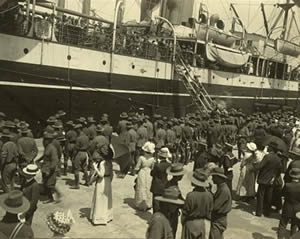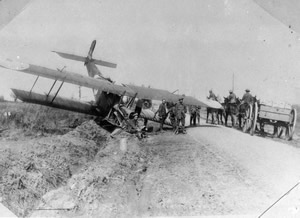History Stage 1
Overview

Queensland troops leaving on the SS Omrah for service in the First World War, 1914
©Public domain (State Library of Queensland)
Students investigate everyday life, changing technologies and remains of the past in the context of the First World War. They investigate transportation of people, animals, equipment and mail 100 years ago and schooling of the period. Students also identify the significance of personal and community symbols of remembrance.
Teaching and learning activities

A crashed aircraft and transport by horse and cart during the First World War
©Public domain (State Library of NSW)
1. Challenge — How were people transported 100 years ago?
-
Collect and display images of different transport types from 100 years ago.
-
Use a world map or globe; identify Australia and then the area of the First World War. How did people move around from one place to another inside Australia? How did the soldiers get to the war in Europe 100 years ago?
-
Develop students’ understanding of the challenge of moving men, horses and supplies from Australia to the war in Europe, including the time taken. Also consider the challenge of transporting letters and postcards as the main form of communicating.
-
What would it have been like to have had a relative serving in the war so far away 100 years ago? Students develop a role play farewelling a family member who is heading off to war. Refer to Experiences > Perspectives tab.
2. Change — How has family life changed or remained the same over time?
What was it like going to school during the First World War in Australia?
-
Source: NSW School house Museum images of a 1910 classroom. Use historical language to develop students’ understanding of change and continuity to examine what a classroom was like in 1914. Use a series of questions to examine the similarities and difference from then to now.
-
Source: Australian Comforts Fund (accessible from Experiences > Patriotic Support tab). View the image of school children with knitted socks and discuss how they have contributed to the war effort.
-
Additional sources: NSW Schools and the Anzacs; Patriotic fundraising: Public school children help out.
-
Play some children’s games from the era such as ‘fly’ and skipping with a long rope. Use some skipping chants. Source: Chants and rhymes.
3. Community — What aspects of the past can you see today?
-
Identify symbols of remembrance and where you will see these in the local community. What events are these symbols connected to?
-
Brainstorm symbols of remembrance, such as memorial gardens, memorial halls, plaques, rosemary bushes, pine trees, memorials, monuments, honour boards. Will other communities also use these symbols?
-
What personal items do people have to remember someone special who has died? Are these similar to the symbols to commemorate those who died in war? Refer to Personal stories: Brothers Lost under the heading Multiple losses (accessible from Why commemorate? > Impacts of war tab).
-
Use images of commemorative symbols for students to annotate with a description of their significance.
Learning concepts
These additional questions can be used for discussion or further investigations.
Challenge
What would it have been like to have had a relative serving in the war so far away 100 years ago?
Change
What was it like going to school during the First World War in Australia?
Caring
What remains of the past are important to the local community? Why?
Community
What symbols of remembrance remain in the local community?
Commemoration
What is the significance of the Centenary of Anzac to local communities?
Syllabus links
HT1-1 communicates an understanding of change and continuity in family life using appropriate historical terms
HT1-2 identifies and describes significant people, events, places and sites in the local community over time
HT1-4 demonstrates skills of historical inquiry and communication
Activity 1
The impact of changing technology on people's lives (ACHHK046)
-
identify examples of changing technologies in their home or community
-
discuss the similarities and differences of technology from the past through a range of sources and sequence them over time
Activity 2
Differences and similarities between students' daily lives and life during their parents' and grandparents' childhoods, including family traditions, leisure time and communications (ACHHK030)
-
discuss similarities and differences from generation to generation, for example, family celebrations and traditions, leisure activities and changes in technology/communications over time through a range of sources
Activity 3
The importance today of an historical site of cultural or spiritual significance; for example, a community building, a landmark, a war memorial (ACHHK045)
-
identify an historical site or sites in the local community. Discuss their significance, why these sites have survived and the importance of preserving them